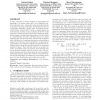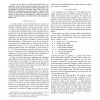797 search results - page 14 / 160 » Spatial Relations Analysis by Using Fuzzy Operators |
GECCO
2005
Springer
14 years 2 months ago
2005
Springer
A fuzzy controller is usually designed by formulating the knowledge of a human expert into a set of linguistic variables and fuzzy rules. Among the most successful methods to auto...
FUZZIEEE
2007
IEEE
14 years 3 months ago
2007
IEEE
— In this paper we present information about our experiment with a social network of students from one school class. Each pupil has characterized his/her relationships to all sch...
AAAI
1996
13 years 10 months ago
1996
This paper describes the spatial aggregation language and its applications. Spatial aggregation comprises a framework and a mechanism for organizing computations around image-like...
SIGMOD
2000
ACM
14 years 1 months ago
2000
ACM
We discovered a surprising law governing the spatial join selectivity across two sets of points. An example of such a spatial join is "find the libraries that are within 10 m...
SAS
2004
Springer
14 years 2 months ago
2004
Springer
Role logic is a notation for describing properties of relational structures in shape analysis, databases and knowledge bases. A natural fragment of role logic corresponds to two-va...


